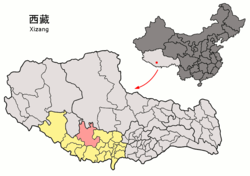|
Ngamring County
Ngamring County (Tibetan: ངམ་རིང་རྫོང་།; Chinese: 昂仁县) is a county of Xigazê in the Tibet Autonomous Region, China. "Ngamring County, sometimes referred to as the gateway to Mount Kailash and Far West Tibet, is the barren area which divides the Raga Tsangpo and the Brahmaputra."[2] The office place of the county is located in Kagar, population 1,700, at an elevation of 4,380 m (14,370 ft).[3][4] Administration divisionsNgamring County is divided into 2 towns and 15 townships.
Landmarks and monasteriesThe Chung Riwoche Stupa is located on the north bank of the Brahmaputra. "A narrow iron bridge spans the river here, alongside an original iron-chain footbridge attributed to Tangtong Gyelpo,"[2] the founder of Tibetan opera, who was born in Ngamring County. "Legend has it that the iron chain bridge over the Xiongqoi River ... was built with funds collected by Tongdong Gyaibo through performances."[5][6] Another point of interest is the Ralung Chutse hot spring, which has camping and a guest house.[2] Zangzang Lhadrak Cave in Ngamring County was where Padmasambhava hid the "Northern Treasures," which consisted of "a number of texts and various sacred objects in a maroon leather casket." These texts and objects were removed in 1366 by Vidyadhara Gödem, and became known as the Dzö Nga (mdzod lnga) or Five Treasuries. The "Northern Treasures" were taught at the Dorje Drak Monastery, and include the Künzang Gongpa Zangtha teachings, a collection of Dzogchen instructions.[7] Ngamring Monastery[8] or Ngamring Chöde (Wylie: ngam ring chos sde[9] ) produced many important scholars.[10] It was founded in 1225 as a Sakya monastery when "the Ngamring ruler Drakpa Dar (Grags pa dar), also known as Yöntsun (Yon btsun), invited the Sakya master Shākya Sengé (Shākya seng ge) to Ngamring and founded the monastery there."[11]
The monastery also followed the Jonang and Bodongpa traditions. It became a Gelugpa monastery at the time of the 5th Dalai Lama. "Tangtong Gyalpo's teacher Ka Ngapa Paljor Sherab (Bka' lnga pa Dpal 'byor shes rab) was the ninth abbot."[11] TransportNotable persons
Gallery
References
External links
|
||||||||||||||||||||||||||||||||||||||||||||||||||||||||||||||||||||||||||||||||||||||||||||||||||||||||||||||||||||||||||||||||||||||||||||||||||||||||||||||||||||||






